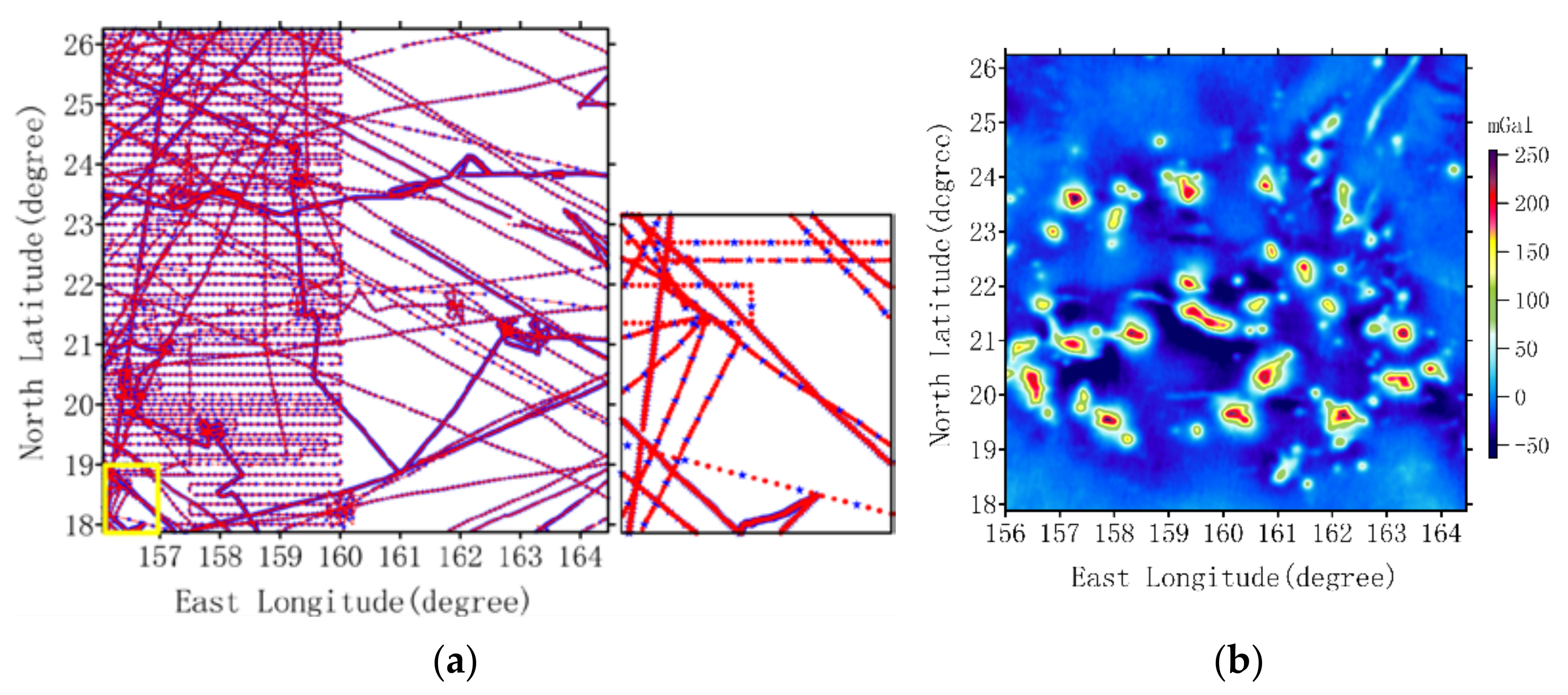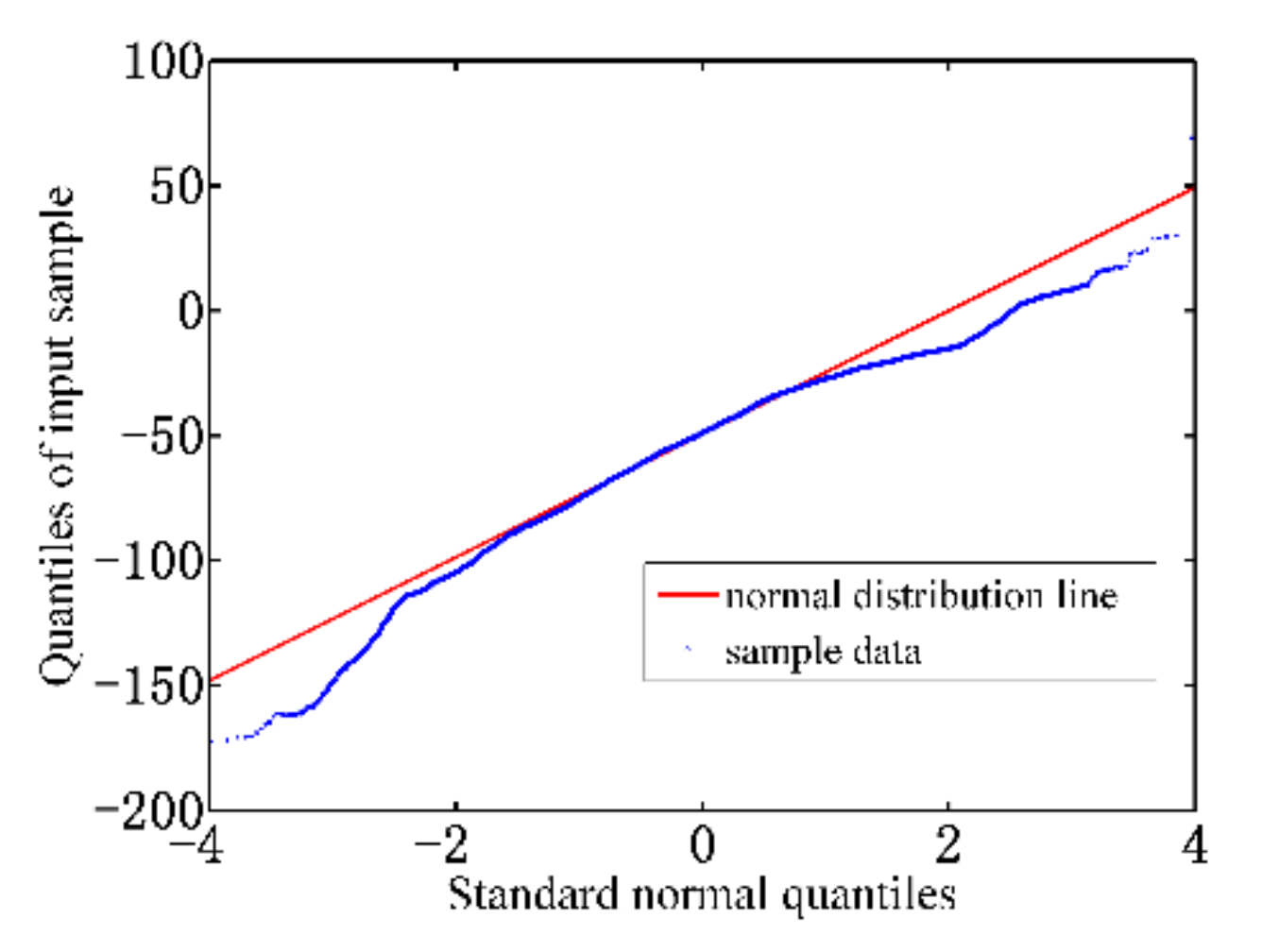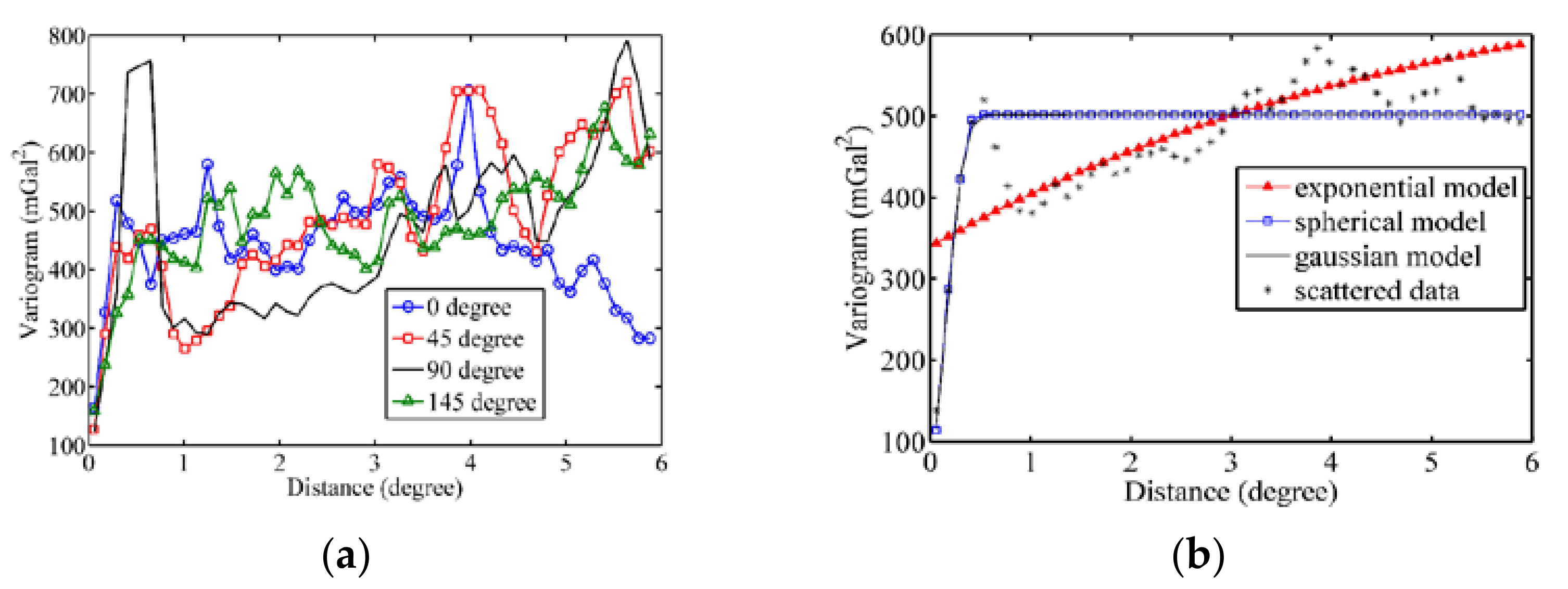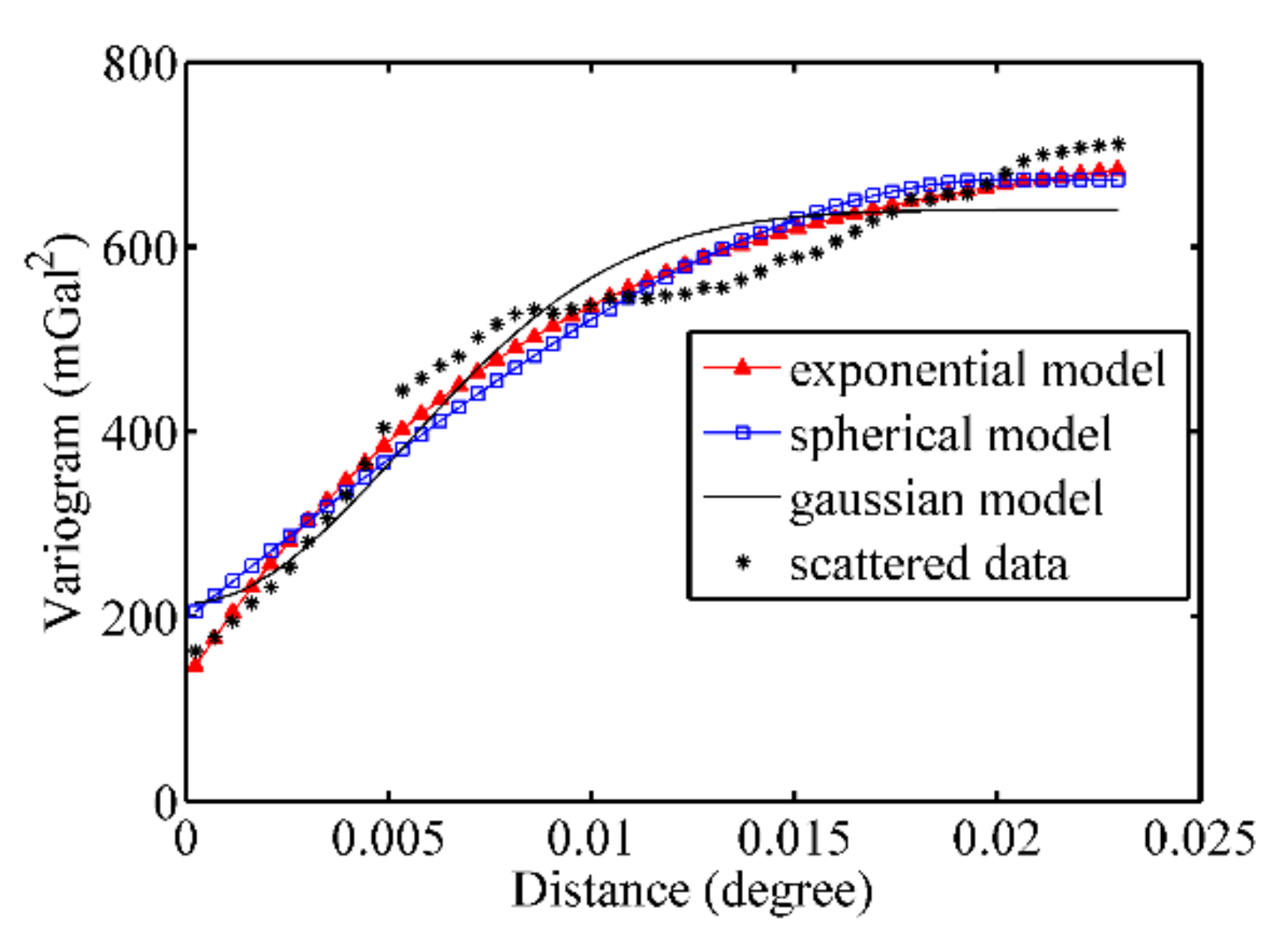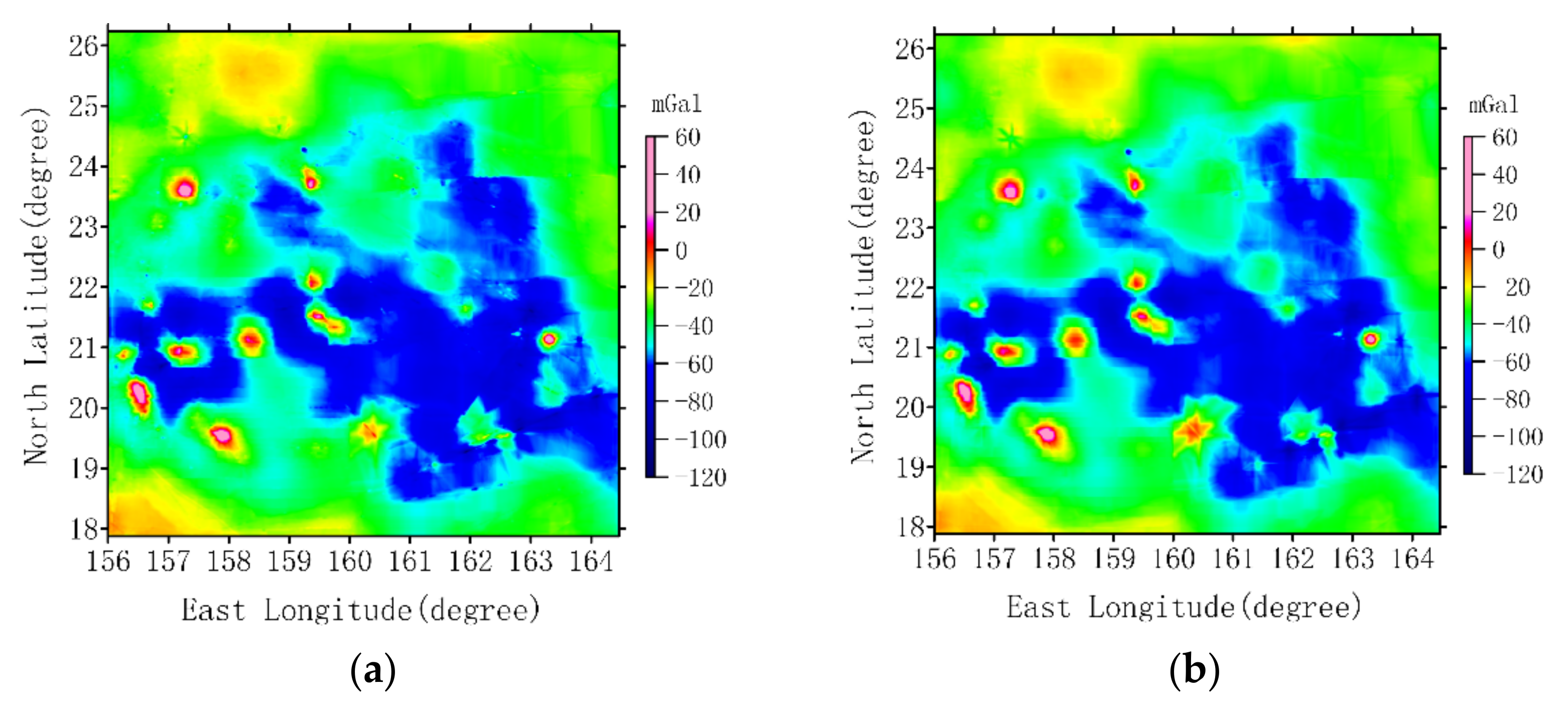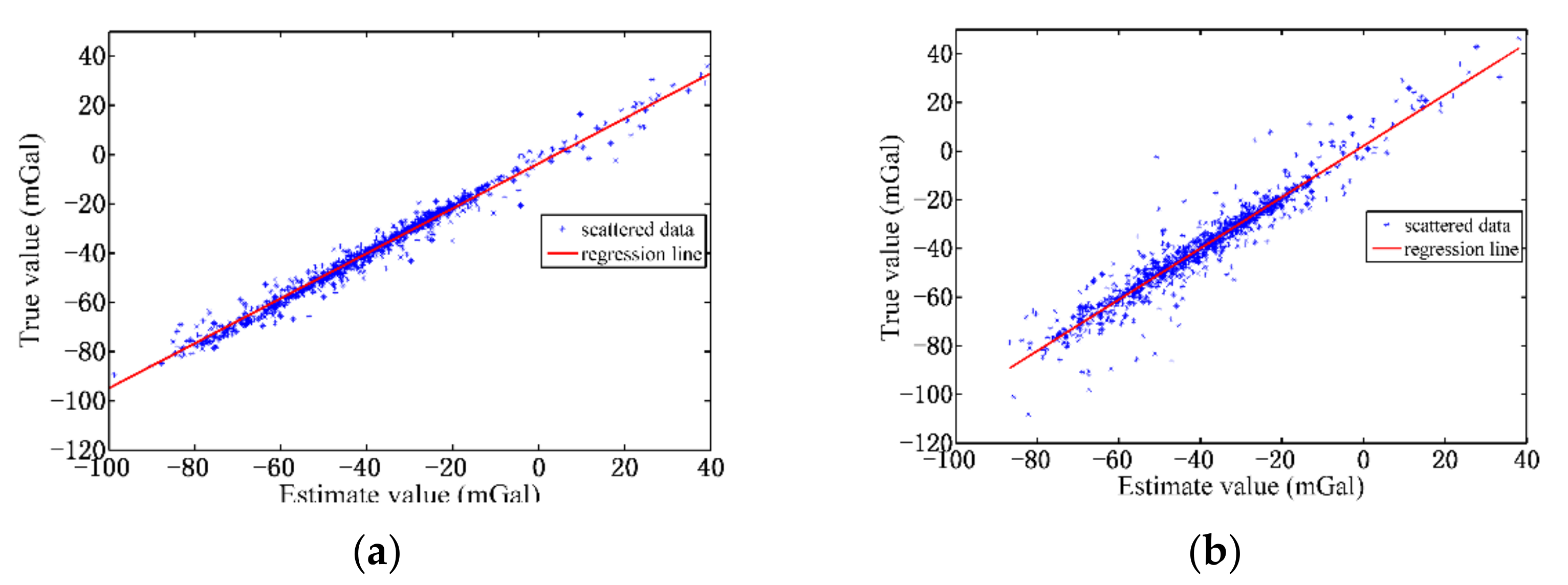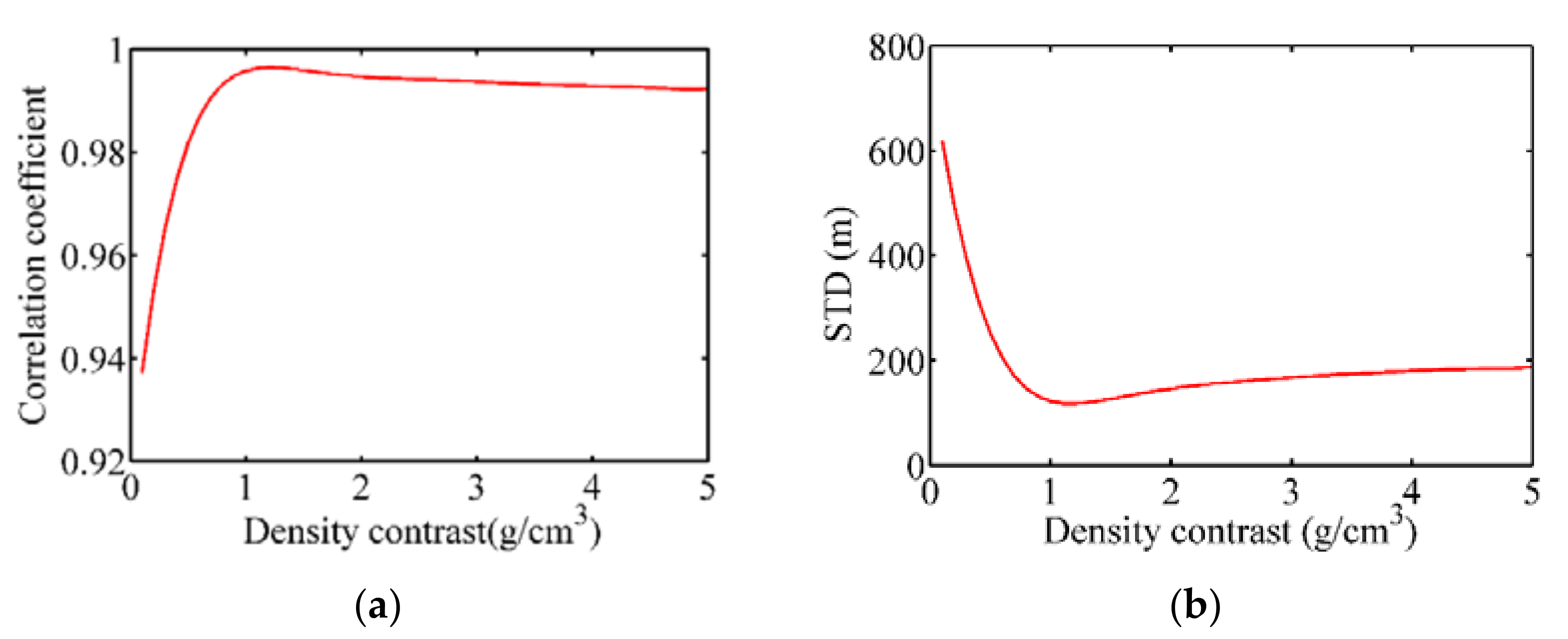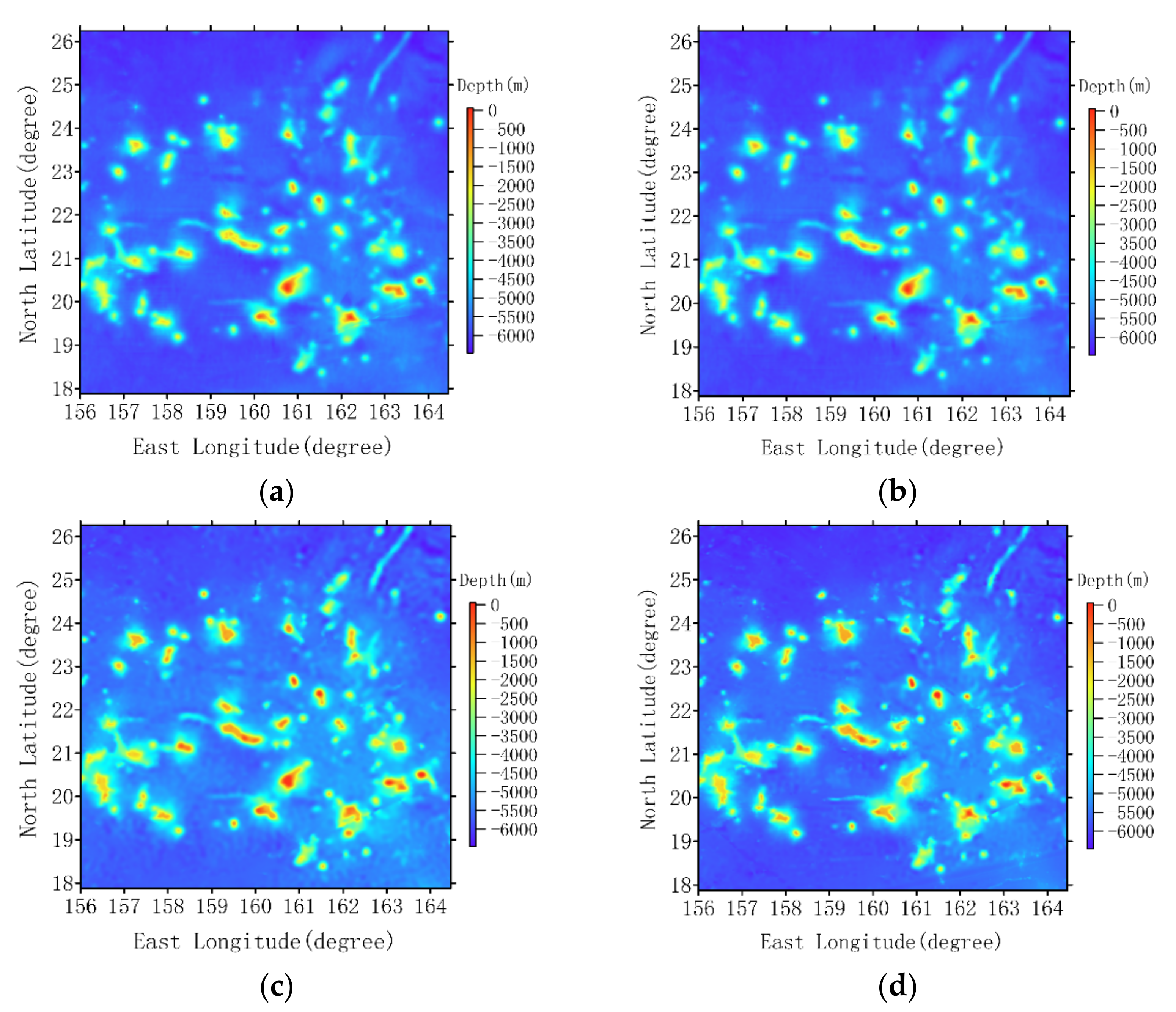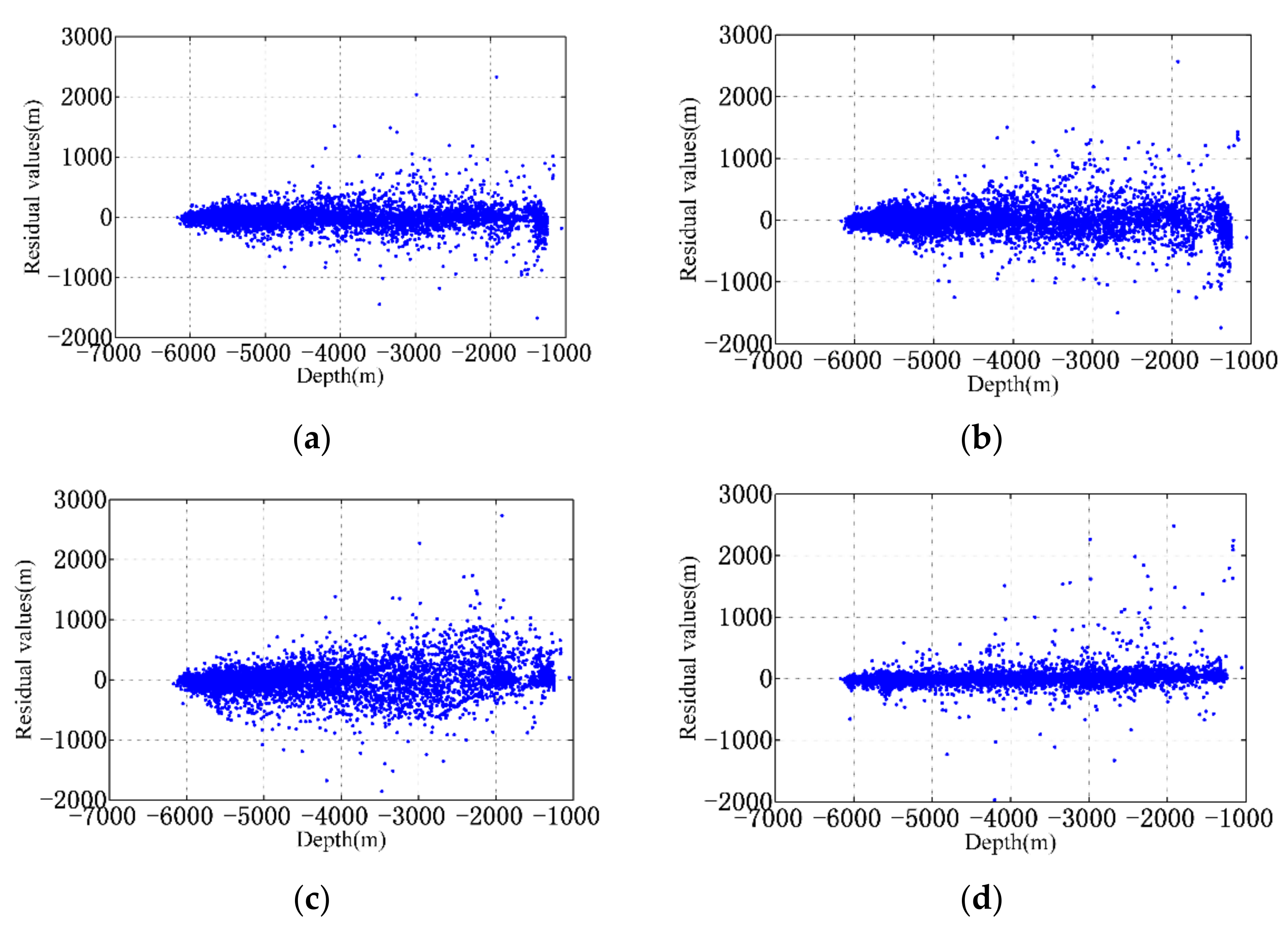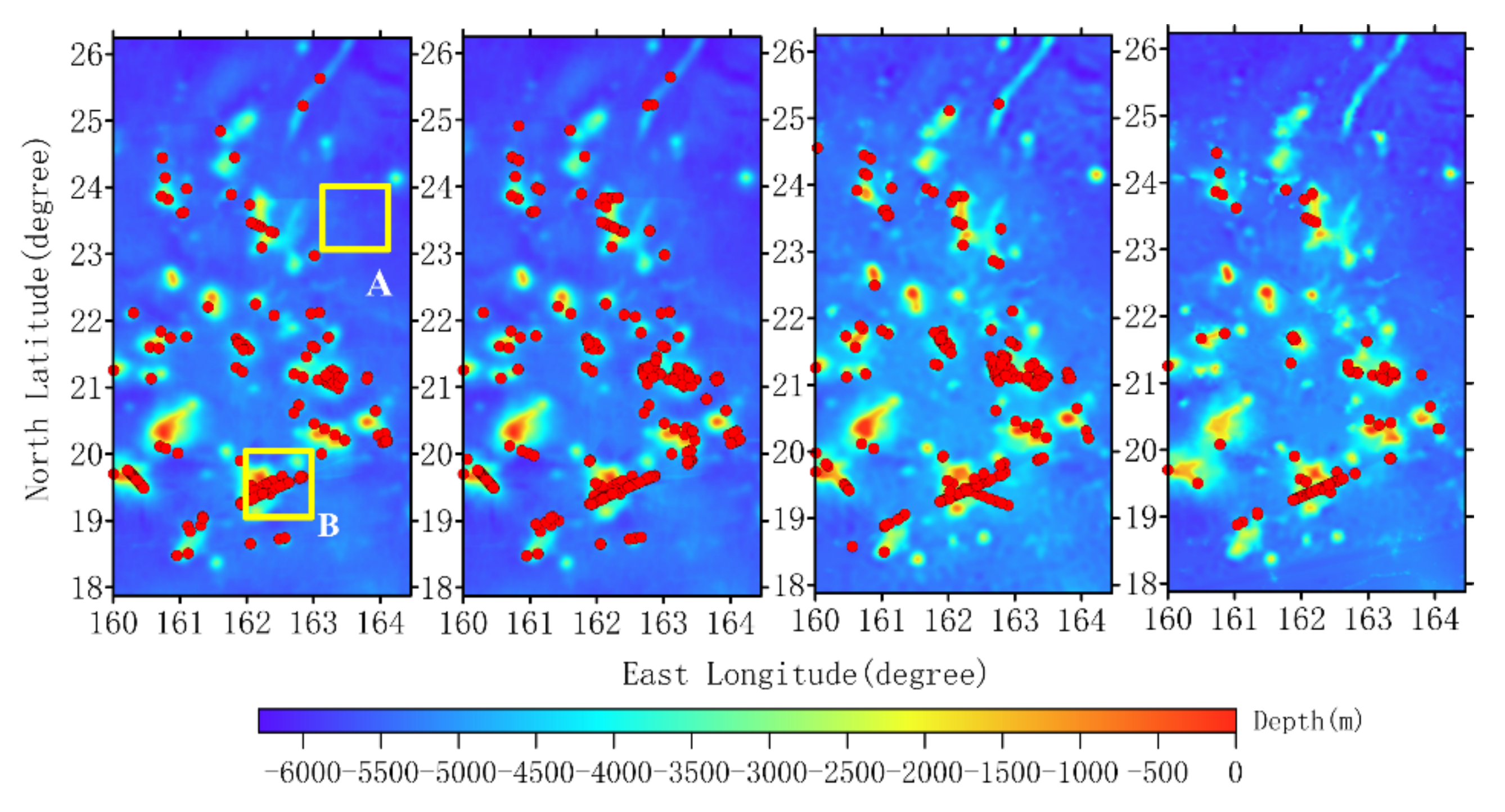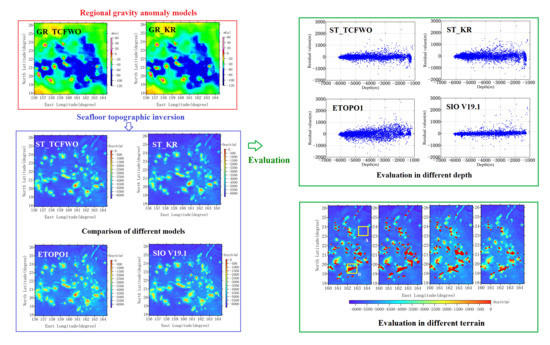1. Introduction
The oceans account for about 71% of the world’s total area and are rich in natural resources. Comprehensive seafloor topographic information, on one hand, can provide support for proper development of resources. On the other hand, the topographic information combined with gravity anomaly information ensures navigation safety [
1]. Generally, shipborne sounding technology is one of the methods to obtain seafloor topography, which has high accuracy but is time-consuming for large areas. Fortunately, the satellite altimetry can quickly derive global marine gravity information [
2], and the topography can be constructed based on the correlation between seafloor topography and gravity information [
3]. The method of inversion of seafloor topography by satellite altimetry makes up for the deficiency of traditional sounding technology. Therefore, the exploration of using gravity information to invert seafloor topography has never stopped. With the development of space technology, there are more and more altimetry satellites [
4,
5,
6,
7], such as, Geo-sat, ERS-1/2, Jason-1/2/3, Envisat, Cryosat-1/2, HY-2, etc. The accuracy of marine gravity constructed by satellite altimetry has reached 2–3 mGal in most areas [
8,
9,
10,
11,
12]. Consequently, it promotes the research of seafloor topography inversion [
13,
14,
15,
16,
17]. Many methods have been proposed for inversion of seabed topography using gravity information, for example, linear response function technique [
18], gravity geologic method (GGM) [
19], least square configuration method [
20] and linear regression analysis [
21]. One of them, the GGM was originally proposed to predict the depth of bedrock by Ibrahim and Hinze [
22], and then applied to the inversion of seafloor topography. According to the control points of shipborne sounding measurements, the free air gravity anomaly is divided into regional and residual gravity, and then the terrain is inverted based on the correlation between residual gravity anomaly and seafloor topography. The method is carried out in the space domain, which is simple and has high inversion accuracy. Therefore, it has been applied and improved in many references. In 2011, Kim, J.W. et al. [
23] proposed the tuning density difference GGM which solved the problem of determining the density contrast. In 2017, Xiang et al. [
24] proposed an adaptive triangulated finite element approximation method for non-uniform control points which solved the long wavelength accuracy difference is too large because of the uneven distribution of depth control points. In 2018, Kim and Yun [
25] verified the effectiveness of the GGM in the shallow water area. In 2020, Xing [
26] used a three-dimensional rectangular model to replace horizontal thin plate model to construct short wavelength gravity anomaly, and integrated prior terrain information by regularization method to improve the accuracy of seafloor topography inversion.
According to GGM principle, grid processing of discrete regional gravity anomaly data is crucial for seafloor topography inversion. However, there are few studies on how to improve the grid accuracy of regional gravity field. Moreover, there are many grid methods [
27,
28,
29,
30], so it is necessary to select them. Among them, kriging algorithm has advantages in space prediction and uncertainty analysis. It is widely used in geophysics, geology, aerospace, meteorology, image processing and other fields [
31,
32,
33,
34,
35]. Hence, we try to improve this method to optimize the regional gravity anomaly model.
Due to the limitation of shipborne sounding technology, the distribution of depth control points is relatively sparse especially in the Southern Ocean [
14], which has a great impact on the grid construction of regional gravity anomaly model. Compared with other interpolation methods, the kriging algorithm is based on spatial autocorrelation analysis and the spatial variation analysis of data to obtain the unbiased optimal estimate [
36], it has advantages for sparse data interpolation. Moreover, the GGM assumes that the residual gravity anomaly has an approximate linear correlation with the seafloor topography, the non-linear influence is ignored [
37]. This leads to the existence of some topographic information in the regional gravity anomalies. Hence, we proposed the topography constraint factor weight optimization (TCFWO) method by introducing a topographic factor to optimize the weight of kriging algorithm for regional gravity data interpolation. In the TCFWO method, the horizontal and vertical variogram models of regional gravity data were constructed, and the anisotropic effect of the horizontal variogram was considered. Subsequently, we used the TCFWO method to carry out relevant experiments on Marcus-Wake seamount area to verify the effectiveness and practicability of the method.
2. Construction of TCFWO Method
The free air gravity anomaly,
, obtained by satellite altimetry, which is assumed to divided into two parts regional and residual anomaly according to the shipborne depth measurements in GGM [
38]:
where
and
represent the latitude and longitude, respectively.
and
denote as the regional and residual gravity anomalies. In the area of relatively flat terrain change, the relationship between topography and the residual gravity can be assumed by a simple Bouguer plate formula [
37]:
where
is the depth value at point
.
represents the universal gravitational constant (=6.672 × 10
−11 N·m
2/kg
2).
is the deepest depth of the control points within the study area. Both the value of
and
are negative from the sea level down.
is the difference between bedrock density and seawater density. However, in GGM,
needs to be optimized as a parameter to adjust the relationship between residual gravity and topography, its analytical significance exceeds the actual physical meaning [
19]. The common methods to determine the density contrast include downward continuation method [
38] and iterative method [
23], in this paper, the latter method was used. By rearranging the Equation (2), the residual gravity anomalies at the control points,
, can be calculated:
where
are residual gravity anomalies.
are the depth of control points. Therefore, the corresponding regional gravity anomalies
can be calculated.
where
are the free air gravity anomalies at control points, which can be obtained by bilinear interpolation from the satellite altimetry derived gravity model. Once the residual gravity anomaly model is acquired, the seafloor topography model can be estimated according to Equation (2). However, the regional gravity anomaly model should be constructed first.
Evidentially, the regional gravity anomalies are discrete distribution, hence, it is necessary to grid it. According to the TCFWO method, the construction process of regional gravity field is as follows.
The
at the control points can be calculated according to Equation (4). Then, the unknown value of regional gravity anomaly,
, at the predicted position can be estimated [
30] by:
where
n is the number of control points.
is the predicted position coordinate of unknown attribute value.
are weight values assigned to the known points, which determine the results of gridding. Hence, the step to determine weight values is crucial.
The estimation of TCFWO method is unbiased and optimal, just like kriging algorithm. Therefore, the estimated value
satisfies the following conditions.
where
is the real value at
point. E[·] is the mathematical expectation symbol. Var[·] represents the variance solution symbol. In addition, based on the second-order stationary hypothesis, the variable data satisfies the following two conditions [
39]:
where
is any constant.
is the covariance calculation symbol of the variable.
are the attribute value of two arbitrary points.
is a function only related to the distance
between two variables.
According to the unbiased and error optimal characteristics of TCFWO method for estimation value, a new objective function
is constructed by combining Equations (5)–(8) and using Lagrange multiplier method. Hence, the problem of determining weight values,
, is transformed into the calculation of equation optimization with constraints of
.
where
is the Lagrange coefficient.
is the variogram value between the control point
and the predicted point
.
is the variogram value between
and
. The value of variogram is a statistic describing the spatial correlation of data, which is defined as the variance of the difference between two points. Hence, the
and
can be calculated by the experimental variogram Equation (10) [
30]:
where
and
are the regional gravity anomaly at position
and
.
is the Euclidean distance between two points namely the lag distance.
Then, the partial derivative of
with respect to
and
are calculated, and the results after derivation are zero. Finally, the equations for determining the weight value are as follows [
31]:
From the Equation (11), the values of variogram are important for weight determination. However, the ordinary kriging algorithm only considers the influence of two-dimensional factors on variogram values. In order to calculate and optimize the weight values
, this paper introduced the topographic factors,
, as the third variable factor based on longitude and latitude coordinates. Thus, the variogram models of gravity anomaly in horizontal and vertical directions could be constructed, respectively, and added by equivalence weight:
where
and
are the experimental variograms in horizontal and vertical directions, respectively.
is the optimized experimental variogram. The
and
are the lag distance in horizontal direction and vertical direction, respectively [
40]:
where
and
denote the coordinates of two shipborne measurements control points with known attributes, respectively.
The values calculated by Equation (12) are experimental variogram, which are discrete points. Generally, it is necessary to use the least square algorithm to fit the variogram models based on the theoretical variogram function [
41] and determine the better models according to the fitting results. Then, using the determined theoretical function model, the variogram values between the corresponding points are calculated. Finally, the formula of TCFWO method for gridding regional gravity anomaly is expressed as follows:
where
are the optimized weight values.
are the best fitting variograms of
. Other symbols have the same meaning as above.
Therefore, based on the above analysis, the process of gridding regional gravity anomaly model and inversion of seafloor topography using TCFWO method is as follows.
Firstly, satellite altimetry derived gravity anomaly at the control points, , are divided into two parts residual information, , and regional information . There the is determined based on the Equation (3).
Secondly, the experimental variogram models of regional gravity anomaly data, , in horizontal and vertical directions are calculated, respectively, according to Equation (12). Based on the theoretical variogram model, the least square algorithm is used to fit the experiment variogram model.
Then, the values of best fitting theoretical variogram are substituted into the TCFWO Equation (14), to realize the grid processing of regional gravity anomaly and construct a model in the region.
Finally, the gridding of regional gravity anomaly model is subtracted from the satellite altimetry derived gravity anomaly model to obtain the residual gravity anomaly model. According to the Equation (2), the topographic model is calculated.
